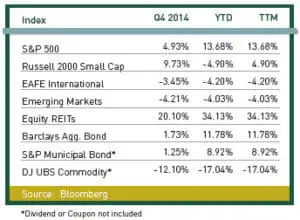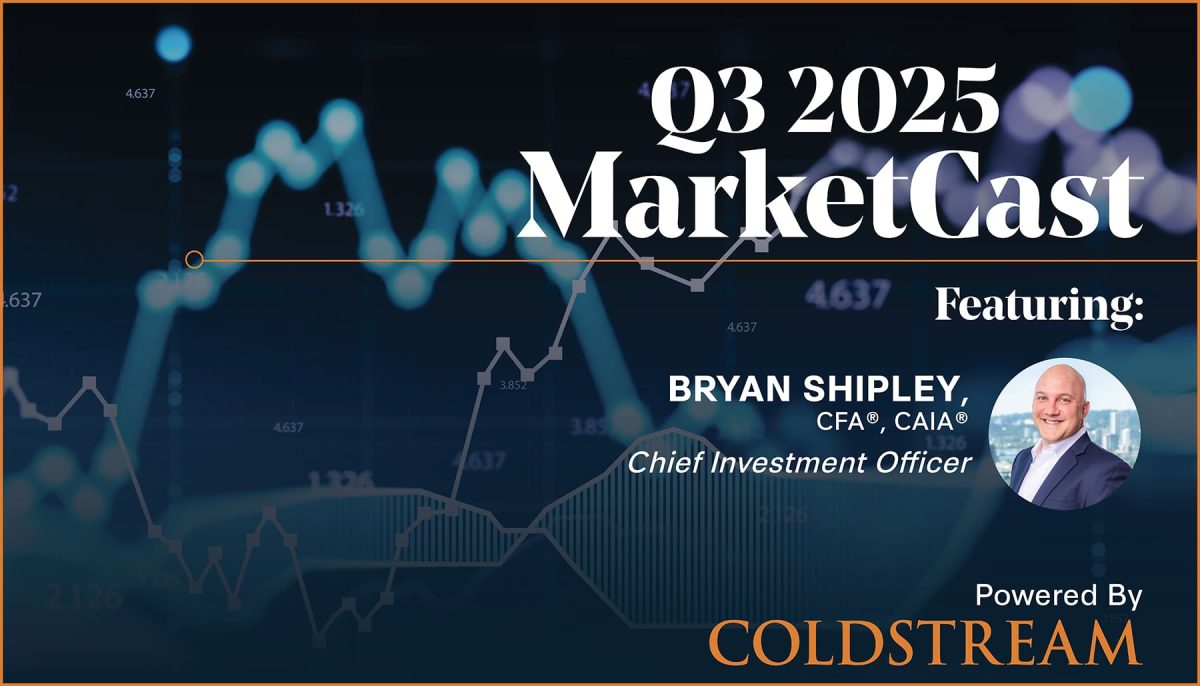
Insights
January 27, 2015
Oil Prices and Market Volatility Expectations
In Market Commentary
The end of 2014 brought yet again an increase in market volatility, angst surrounding global economic growth, and continued unease about the longer term central bank strategies and actions. Several key points are worth highlighting:
- Volatility in the stock market has picked up in the past few months. Concerns about global economic growth, the health of emerging markets, geopolitical tensions, and plunging oil prices have investors on edge.
- Investors continue to rotate toward defensive sectors such as consumer staples, health care, and utilities, helped in part by the steady decline in long-term interest rates. More cyclical sectors such as basic materials, industrials, and technology are falling out of favor.
- The US economy continues to improve at a below normal but nonetheless growing pace. It is hard to find another area around the globe in the same condition. Europe has stalled, Russia is close to a depression with the collapse of their currency, and their number one export, oil, is down 50% in US dollar terms.
Oil Prices continue to Collapse
As of mid-December the S&P 500 was trading near all-time highs, but that figure understates the extent of recent volatility. Investors have become terrified of  the collapse in crude oil prices since June. The speed and extent of the recent plunge in oil prices took us by surprise after more than three years of relatively stable prices in the $100/barrel range. Supply and demand appears to be one of the principal reasons for the current oil glut: North America’s energy boom has increased supply, augmented by surprisingly strong production out of the Middle East and North Africa despite political turmoil in those regions. At the same time, the demand outlook has weakened, with many economies around the world slowing (China) or in borderline recessions (Japan, Brazil, much of Europe). As oil and gas companies cut back on drilling, there may be an excess supply of rigs, equipment, labor, and so on, resulting in lower services pricing and lower marginal costs.
the collapse in crude oil prices since June. The speed and extent of the recent plunge in oil prices took us by surprise after more than three years of relatively stable prices in the $100/barrel range. Supply and demand appears to be one of the principal reasons for the current oil glut: North America’s energy boom has increased supply, augmented by surprisingly strong production out of the Middle East and North Africa despite political turmoil in those regions. At the same time, the demand outlook has weakened, with many economies around the world slowing (China) or in borderline recessions (Japan, Brazil, much of Europe). As oil and gas companies cut back on drilling, there may be an excess supply of rigs, equipment, labor, and so on, resulting in lower services pricing and lower marginal costs.
While it is clear that the Economics 101 supply and demand theories rule most markets most of the time, there are other factors at work as well. If one were to examine the price pattern of the US dollar versus almost every other major currency since last summer, it has gone up in value in almost a straight line on a relative basis. As dollar denominated crude oil becomes more and more expensive around the globe with the strength of the dollar vs. other currencies, this strongly coincides with the price drop in oil.
However, the dollar is not strengthening in a vacuum. It is the direct result of central bank activity. After the US Central bank began its record amounts of quantitative easing and low interest policies 12 years ago, the value of the dollar weakened precipitously relative to most major foreign currencies. The value of almost all commodities went up in dollar terms but probably none more so than crude oil. Crude oil was $20 per barrel in 2002. Targeted reductions in interest rates to stimulate the economy culminated in record amounts of non-traditional asset purchases by our central bank in 2009 creating a commodity asset bubble in dollar terms. Oil did stabilize after a dramatic drop in 2009 on economic woes, but now it seems clear we are heading towards a period of normalization of interest rates in the US over the next 12 to 18 months, while other developed countries’ central banks are expected to initiate (Europe) or expand (Japan) quantitative easing and zero interest rate policies. As a result the dollar has risen substantially versus other currencies. This has caused dramatic drops in many commodities not just oil, creating significant deflationary pressures, especially in Europe and Japan.
Fortunately for longer term oriented investors like ours, US central bank activities have historically had no lasting long term influence on the outcome of broadly diversified investment portfolios that are weighted towards long term equity market exposure and long term earnings growth, while still meeting short term client needs. We expect global Gross Domestic Product will continue to grow over time, even in Europe at some point! Global growth tends to lead to profits for the most profitable firms in the world.
Related Articles

July 11, 2025
The Return of Diversification


July 10, 2025
Watch Coldstream’s MarketCast for Third Quarter 2025


June 24, 2025
Managing Increased Uncertainty in the Middle East


